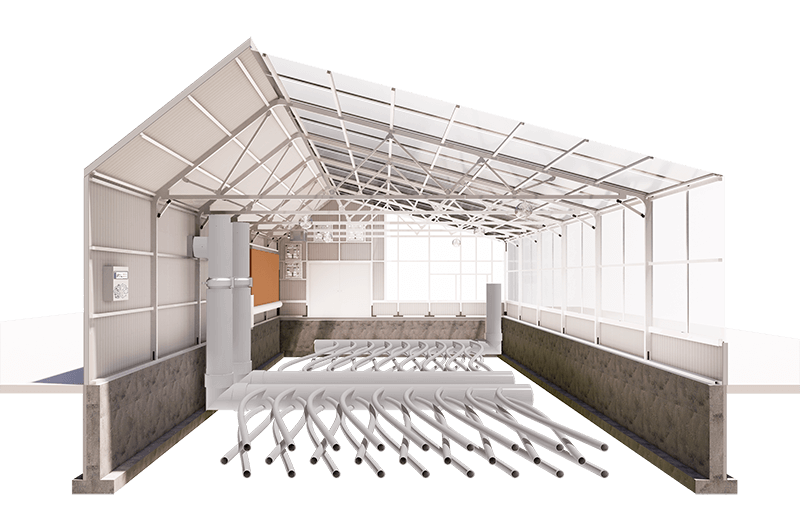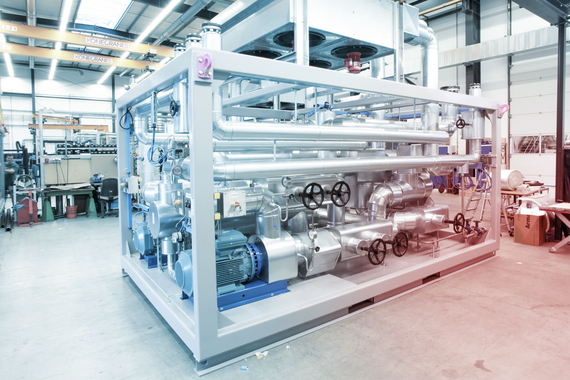Advancements in Heat Transfer Systems: What You Need to Know for Optimum Performance
Developments in Heat transfer systems are transforming efficiency across different sectors. Advanced materials like graphene and nanofluids guarantee substantial renovations in thermal conductivity. The combination of IoT and device discovering supplies opportunities for real-time tracking and improved energy performance. However, the landscape of thermal administration is swiftly developing (DVS Heat Transfer Systems). Comprehending these growths is crucial for attaining ideal system performance and sustainability in the future. What certain developments are forming this transformation?
Emerging Materials for Enhanced Heat Transfer

Advanced Heat Exchanger Layouts
While typical Heat exchangers have offered their purpose in different applications, progressed layouts are now emerging to fulfill the raising needs for effectiveness and performance. These ingenious designs, such as plate, shell-and-tube, and finned-tube Heat exchangers, include improved surface and boosted flow patterns to raise thermal transfer rates. On top of that, compact layouts permit for reduced space needs without jeopardizing efficiency. Advanced products, such as composites and corrosion-resistant alloys, furthermore improve durability and performance under severe problems. Simulation modern technologies and computational liquid characteristics are increasingly employed to fine-tune these layouts, making sure peak Heat transfer characteristics. As markets look for to reduce power usage and make the most of result, the adoption of innovative Heat exchanger layouts is crucial in attaining these purposes.
The Function of Nanotechnology in Heat Transfer
Nanotechnology plays a necessary function in enhancing thermal conductivity within Heat transfer systems. By adjusting materials at the nanoscale, researchers have accomplished substantial enhancements in power performance. These developments not only enhance performance yet additionally add to even more lasting power services.
Improved Thermal Conductivity
Substantial developments in thermal conductivity have emerged via the application of nanotechnology, changing Heat transfer systems throughout different sectors. By integrating nanoparticles right into Heat transfer fluids and materials, researchers have achieved remarkable rises in thermal conductivity. These nanoparticles, such as carbon nanotubes, graphene, and steel oxides, enhance the Heat transfer buildings due to their high surface area and distinct thermal characteristics. The resulting compounds show enhanced performance in applications ranging from electronic devices cooling systems to eco-friendly power technologies. Furthermore, the capability to tailor the size, shape, and make-up of nanoparticles allows for optimized thermal monitoring remedies. Therefore, nanotechnology remains to play a crucial function in the advancement of much more reliable and efficient Heat transfer systems, paving the means for improved industrial applications.
Energy Performance Improvements

Integration of IoT in Heat Transfer Equipments
The combination of IoT in Heat transfer systems presents the execution of wise sensors that boost functional performance. These sensing units allow real-time information surveillance, permitting instant adjustments and optimizations. This technical improvement has the prospective to significantly enhance efficiency and power administration in Heat transfer applications.
Smart Sensors Execution
As Heat transfer systems develop, the integration of smart sensing units through the Web of Points (IoT) has actually arised as a transformative strategy. These sensing units allow real-time surveillance of temperature, flow, and stress prices, enhancing system performance and reliability. By collecting and transferring data, they help with aggressive maintenance, decreasing the threat of system failings. Furthermore, wise sensing units add to energy cost savings by refining functional criteria based upon environmental problems. Their capability to analyze fads and anomalies enables for educated decision-making, making certain peak performance of Heat transfer systems. As sectors increasingly embrace this innovation, the execution of wise sensors stands to transform just how Heat transfer systems are handled, leading the way for better sustainability and boosted efficiency outcomes.
Real-Time Data Monitoring
Just how can real-time data keeping an eye on improve the efficiency of Heat transfer systems? By integrating Web of Things (IoT) modern technology, Heat transfer systems can utilize constant information collection from clever sensing units. This real-time tracking allows for prompt evaluation of flow, stress, and temperature level rates, making it possible for operators to recognize ineffectiveness promptly. Subsequently, adjustments can be made to optimize efficiency, decrease power usage, and expand equipment lifespan. In addition, anticipating upkeep can be implemented, reducing unforeseen downtime and expensive repair work. The ability to picture efficiency metrics via control panels improves decision-making, cultivating a positive method to system monitoring. Eventually, real-time data keeping track of not only improves functional efficiency yet also adds to sustainability goals within industrial procedures.
Power Efficiency and Sustainability Trends
Power efficiency and sustainability fads are reshaping the landscape of Heat transfer systems, driving technology and conformity across numerous industries. Organizations are progressively prioritizing energy-efficient designs to decrease functional expenses and decrease ecological effects. The combination of sustainable power resources is becoming more prevalent, making it possible for Heat transfer systems to run sustainably while YOURURL.com satisfying governing demands. Additionally, improvements in innovations and products advertise reduced energy usage and improve general efficiency. Lifecycle analyses are also acquiring grip, permitting firms to evaluate the environmental effect of Heat transfer systems from manufacturing to disposal. This focus on sustainability not only supports company responsibility but also placements organizations competitively in a market where customers increasingly prefer environment-friendly remedies. Subsequently, energy efficiency and sustainability remain crucial considerations for future advancements in Heat transfer innovation.
Advancements in Thermal Administration Solutions
While the demand for effective Heat transfer remains to rise, innovations in thermal monitoring solutions are arising to resolve both efficiency and sustainability difficulties. Advanced materials, such as phase adjustment products and nanofluids, are being developed to boost Heat transfer effectiveness - DVS Heat Transfer Systems. These materials boost thermal conductivity and permit for much better temperature policy in numerous applications. Furthermore, modern technologies like active thermal control systems are obtaining grip, making it possible for real-time changes to manage Heat circulation successfully. These systems add to energy cost savings and decrease the environmental effect of thermal processes. The combination of IoT in thermal monitoring assists in surveillance and anticipating maintenance, making sure optimized performance and longevity of Heat transfer systems. On the whole, these developments stand for significant strides towards even more lasting thermal administration techniques
Future Directions in Heat Transfer Innovation
Emerging improvements in thermal monitoring services indicate an encouraging future for Heat transfer modern technology. Researchers are progressively focusing on developing materials with exceptional thermal conductivity and improved power efficiency. Advancements such as nanofluids, which include put on hold nanoparticles, supply considerable enhancements in Heat transfer efficiency. In addition, the integration of smart products that visite site adapt to differing temperature level problems is gaining grip, enabling even more efficient and responsive systems. The rise of additive production techniques is also enabling the layout of complicated Heat exchanger geometries that enhance fluid flow. The implementation of maker learning formulas is prepared for to reinvent the optimization of Heat transfer systems, promoting predictive maintenance and efficiency improvement. Collectively, these innovations are positioned to transform the landscape of Heat transfer technologies in various industries.

Frequently Asked Inquiries

Just how Do I Select the Right Heat Transfer System for My Application?
Selecting the best Heat transfer system includes reviewing application requirements, including temperature ranges, fluid homes, and performance needs. Assessing system types, maintenance considerations, and cost-effectiveness also plays an important duty in making a notified choice.
What Are the Maintenance Requirements for Advanced Heat Exchangers?
Upkeep needs for innovative Heat exchangers commonly include routine evaluations, keeping an eye on for leakages, cleansing of surfaces, and ensuring perfect circulation rates. Sticking to producer guidelines guarantees effective procedure and extends the equipment's life expectancy.
Exactly How Do Environmental Variables Affect Heat Transfer Efficiency?
Environmental aspects considerably affect Heat transfer efficiency. Variations in humidity, temperature level, and air movement effect thermal conductivity and convective Heat transfer, eventually affecting system efficiency and requiring consideration throughout the style and operation of Heat transfer systems.
What Safety Requirements Put On Heat Transfer Solutions?
Safety and security requirements for Heat transfer systems usually consist of standards from companies such as ASME and ASTM. DVS Heat Transfer Systems. These standards address materials, style, and functional practices to guarantee reliability, performance, and defense versus threats in different applications
How Can I Repair Common Heat Transfer System Issues?
Fixing typical Heat transfer system concerns includes examining for leaks, ensuring correct liquid circulation, evaluating insulation stability, and verifying temperature differentials. Identifying these elements can assist keep system performance and avoid additional complications.
Nanotechnology plays an important function in improving thermal conductivity within Heat transfer systems. Considerable advancements in thermal conductivity have emerged through the application of nanotechnology, revolutionizing Heat transfer systems across various industries. Developments in thermal conductivity with nanotechnology have paved the way for exceptional enhancements in energy efficiency within Heat transfer systems. Power performance and sustainability fads are improving the landscape of Heat transfer systems, driving advancement and compliance across various industries. The integration of IoT in thermal management facilitates surveillance and anticipating upkeep, making sure optimized efficiency and long life of Heat try this out transfer systems.